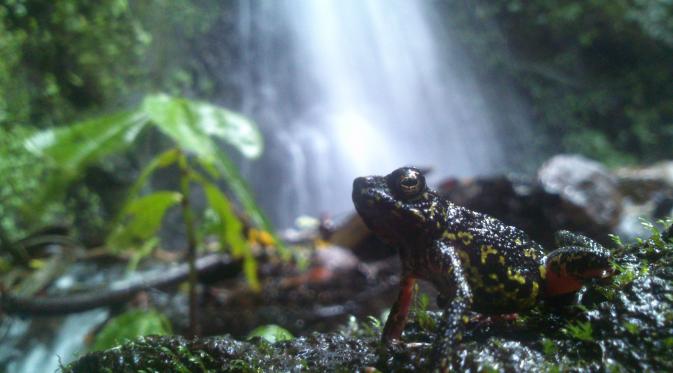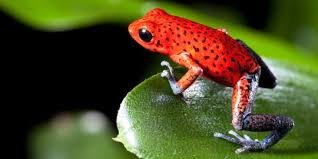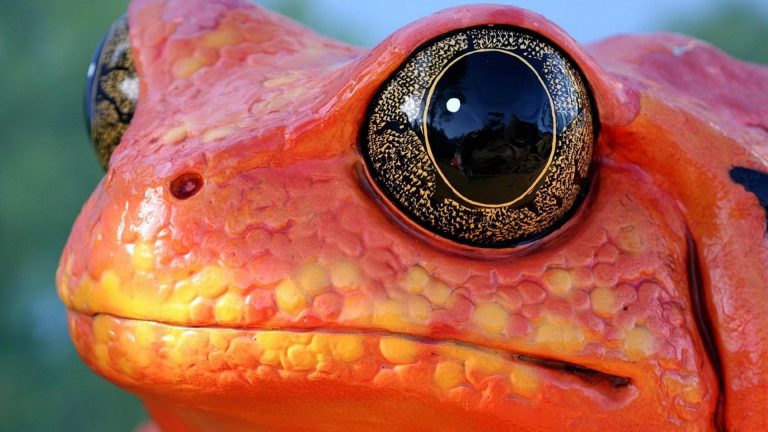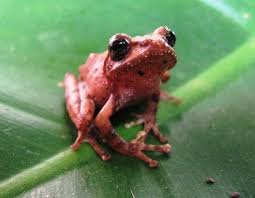Red Frog (Leptophryne cruentata) The Pretty Almost Faded

One more typical Indonesian assets that will be lost and already at the end of the eye. The iconic richness of West Java is the "red frog" or often referred to as the blood frog (Leptophryne cruentata). It is unfortunate that the country that has the title of megadivesity country is also very much the wealth of species that are threatened by the existence of one of these red frogs.
Red frog is an endemic reptile frog found only in West Java, especially in Gunung Halimun-Salak Cipanas National Park and Gunung Gede Pangrango Cianjur National Park. This frog lives in the area near the water flowing at an altitude of 1000-2000 mdpl with a temperature range of 10-24oC and has a high humidity between 60-100%.
Characteristic that can be seen from this red frog is the appearance of the outside with a predominantly red color with blackish red totol like blood. Other special features are small and slender bodies between 20-30 mm, have a small, sometimes unclear parathy gland, no bony plaque on the head, fingertips and slightly swollen fingers, third fingers and to the five form a network up to subarticular bumps.

In 1960 D. S. S. Liem, researchers from Queensland, Australia, conducted this rare animal survey and concluded that the red frog of West Java is a lot of life in the area of Cibeureum, Gunung Gede Pangrango National Park. That is as much as 149 tails during his research. 40 years after the study revealed that the population declined. Even an amphibian expert from the Bandung Institute of Technology, Djoko T. Iskandar, wrote in his book 'Amphibians Java and Bali' in 1998.
Redlist records it with the critically endangered status or final status before the extinction of this animal, but unlike in Indonesia that has not included this endemic animal into a protected species of endangered species.
The cause of the threatened extinction of red frog is estimated due to several things, the first suspicion of Djokoo Iskandar is a result of the eruption of Mount Gede Pangrango a few years ago, dust and volcanic material itersebut allegedly cover the habitat of spawning and contamination of natural circuits dai frog is so there is a decrease in the number of sepesies frog red drastically.
Another allegation says that this frog is attacked by chytridimycosis fungus. This assumption is reinforced by the existence of a favorable environment for the development of chytridimycosis fungi that is at a temperature of 13.5-28oC with a very high humidity, 63-100% in Mount Gede and Halimun-salak.

The alleged decrease in red frog populations due to exploitation to be consumed is little doubt that they belong to the true Bufonidae or frogs that have toxic glands that can not be consumed, and if used for decorative frogs this also has a less attractive color.
Efforts continue to be done from several related views, both researchers and managers of conservation areas. Data collection is still done but has its own difficulties because of the lack of personnel involved to make the data collection intense. Other attempts were made to find out how the populations of these red frogs experienced drastic decreases such as the identification of indications of chytridimycosis fungus attack molecularly but again experiencing constraints such as operational costs and for further testing can only be done in specialized laboratories in the United States and Australia. The last effort is from the manager that is by mgnhimbau every tourist who visit the conservation area of Gunung Gede Pangranggo and Halimun-Salak National Park, especially the waterfall area where this red frog lives so as not to damage the vegetation, do not hurt and bring the red frog out of the habitat because it is a frog that can not live anywhere.

Currently there are many animals that have almost disappeared in Indonesia. Is it our intention to participate in supporting their existence wherever it is as colors in Indonesia and the world?